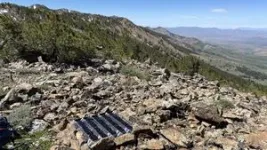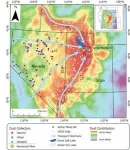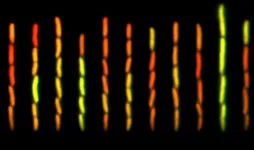(Press-News.org) Airborne dust pollution is a growing problem for residente of Utah and other Western states, especially with the exposed lakebed of Great Salt Lake potentially becoming more hazardous as the lake dries. Natural dust blows from the Great Basin and settles along the western edge of the Wasatch Front, Utah’s major population center, and the surrounding mountains. While airborne, the dust mixes with local human-made materials, potentially contaminating the nearby watershed and resulting in other negative consequences, according to new research from the University of Utah that investigates the influence of urban environments on transient dust.
A study team led by Utah atmospheric scientist Kevin Perry and Jeff Munroe, a geology professor at Middlebury College, considered Earth’s “Critical Zone,” a near-surface layer where organisms interact with rock, air, soils and water. Dust processes such as deposition, erosion and transport influence the Critical Zone.
Dust particles are typically diverse in their composition, as they are influenced by natural environments. However, agriculture, grazing, off-roading, construction, mining and other human activities alter the dust composition, with important implications for places like Utah’s populated Salt Lake Valley.
“The problem is that there are lots of dust sources in the urban area, and when it’s windy and it’s picking up dust from Great Salt Lake and other places upstream, it gets mixed in with this local dust that has a lot more junk in it,” Perry said. “So if we think about the contaminants of concern in Great Salt Lake dust, and then you add in additional contaminants from the local dust, it just makes it that much more potent, and not in a good way.”
Home to 2.5 million people, or three-fourths of Utah’s population, the Wasatch Front is particularly susceptible to dust pollution, so it provides an ideal laboratory for investigating interactions between natural and urban dust, according to the study, which was funded by the National Science Foundation.
“Our dust comes from various sources. We have natural sources like the West Desert, the Bonneville Salt Flats, Sevier Lake, but then we also have a lot of dust from Great Salt Lake and anthropogenic dust sources, quarries at Point of the Mountain, the Staker quarry in North Salt Lake,” said co-author Derek Mallia, a research assistant professor of atmospheric sciences. “This can be locally sourced, but you can also get dust impacts from sources on the other side of the Great Basin. An artifact of being on the eastern side of the Great Basin is we’re just downwind of a ton of dust sources.”
The research team analyzed 29 dust samples collected by Munroe during four separate seasonal periods from 2020 to 2022. These samples were sourced from five passive collectors spanning 500 square miles west of the Wasatch Front, two inside Salt Lake City and Provo, and another at the head of Little Cottonwood Canyon, the ski destination just outside the city.
Part of a long-running project Munroe leads called DUST ^2, or Dust Squared, the team collected dust samples with a low-tech improvised system that uses trough-lined trays filled with large glass beads. Munroe has installed the equipment at mostly mountaintop sites around the Southwest, including the eight used in the study.
(Click here to view a scenic video tour Munroe conducted of all 20 collection sites in Utah, Nevada and southern Idaho in October 2024.)
The trays capture whatever particles fall into these devices. Researchers periodically retrieved the beads and washed off the dust, which they analyzed to determine their geochemical composition, mass flux, color and grain size.
“The dust in the city was way more contaminated with all sorts of metals and other sorts of things than the natural dust,” Perry said.
Their results identified higher concentrations of zinc, calcium, molybdenum, cadmium, copper, lead, cobalt and arsenic in the urban dust. Many of these elements can be traced to mining and smelting, vehicle emissions and heavy industry. Of note, arsenic and cobalt concentrations exceed the U.S. Environmental Protection Agency’s Regional Screening Levels. Moreover, zinc, calcium and copper are particularly harmful for surface waters in the Wasatch Front region.
“A lot of the dust ends up in the snowpack, and then when the snowpack melts, it runs off into the waters,” Perry said. Research team member Greg Carling, a geology professor at Brigham Young University, is analyzing spring runoff from the Wasatch to measure the influx of metals it carries into streams and ultimately into Great Salt Lake.
####
The study, “Mixing of natural and urban dust along the Wasatch Front of northern Utah, USA,” appears in the Jan. 31 edition of Scientific Reports. The lead author is Middlebury’s Jeffrey Munroe, who has a long history of collaborating with Utah scientists, and co-authors include Utah geology research professor Diego Fernandez.
END
Stephen Hauser Wins Breakthrough Prize for Role in Redefining MS
UCSF luminary played a pivotal part in identifying cause of multiple sclerosis, leading to a new generation of game-changing therapies.
Neuro-immunologist Stephen Hauser, MD, whose maverick thinking transformed the treatment landscape for patients with multiple sclerosis (MS), has received the 2025 Breakthrough Prize in Life Sciences.
Hauser, a UCSF professor of neurology and director of the Weill Institute for Neurosciences, was recognized April 5 for overturning ...
Mass General Brigham investigators have linked difficult early life experiences with reduced quality and quantity of the white matter communication highways throughout the adolescent brain. This reduced connectivity is also associated with lower performance on cognitive tasks. However, certain social resiliency factors like neighborhood cohesion and positive parenting may have a protective effect. Results are published in Proceedings of the National Academy of Sciences (PNAS).
White matter are the communication highways that allow the brain networks to carry out the necessary functions for cognition and behavior. ...
Invasive species cause environmental mayhem when they establish themselves in a new ecosystem. But these interlopers can also impact human health directly. Deadly diseases can jump from animals to humans, as the COVID-19 pandemic vividly illustrated.
A new study led by researchers at UC Santa Barbara, University of Réunion and Duke University reveals that the black rat is likely responsible for transmitting the deadly hantaviruses in rural Madagascar, where forested landscapes have been converted to agriculture and settlements. The results appear in the journal Ecology and Evolution.
Rats have been familiar ...
Could a gene regulatory network in gut microbes have evolved its elaborate and tightly regulated molecular machinery only to pump out antibiotics indiscriminately? Researchers from the Institute of Science and Technology Austria (ISTA) show this is an auxiliary function. By maintaining basal levels of genetic activity when the network is in its OFF state, these genes ensure the bacteria remain fit and adaptable to their highly variable environment in the gut. The findings were published in PNAS.
This is the story of a misnomer. And an immense and intricate molecular machinery at that, ...
Washington, April 7, 2025—The American Educational Research Association (AERA) is pleased to announce the appointment of Tabbye M. Chavous as its new executive director, effective August 11, 2025. A nationally recognized scholar and seasoned leader, Chavous brings over 25 years of experience and significant accomplishments in research, teaching, and organizational advancement. Across her career, she has consistently advocated for high-quality, inclusive research, and her equity-oriented leadership is evident in her approaches to building and transforming educational environments.
Chavous succeeds Felice J. Levine, who has served as executive director ...
HERSHEY, Pa. — The list of treatments for low back pain is endless, but few offer relief for the one in four Americans who suffer from this persistent pain and leading cause of disability globally. More than 80% of those with chronic low back pain wished there were better treatment options. Yet, without sufficient pain relief, many people need to take opioids, which can be addictive.
The good news? A multi-institutional team, led by researchers from the Penn State College of Medicine and the University of Wisconsin-Madison, found that eight weeks of either mindfulness or cognitive behavioral ...
Scientists at Johns Hopkins Medicine say they have discovered how a group of proteins linked to Parkinson’s disease and amyotrophic lateral sclerosis act as “guardians” of mitochondria, small organelles, or subunits, within a cell that make and store energy and are found in almost all plants and animals.
The findings, resulting from experiments with genetically engineered mice should advance understanding of the development of Parkinson’s disease — a chronic and progressive neurodegenerative disorder whose causes are not clearly known — the scientists say. Most experts believe Parkinson’s disease is a result of some combination ...
When people let their minds wander during tasks that require attention and active thinking, it can hurt how well they learn and perform the tasks. But there are more passive kinds of learning that require less attention. Péter Simor, from Eötvös Loránd University, and colleagues explored how mind wandering influences learning in tasks requiring little attention in their JNeurosci paper.
Nearly 40 study participants performed a simple learning task while the researchers ...
The growing prevalence of human interactions with artificial intelligence has increased the need for a better understanding of how the brain processes virtual reality. Because how others behave and move can influence how people understand social scenes and even themselves, exploring whether avatar appearance influences virtual interactions is important. To provide insight on this, Vanessa Era and colleagues from Sapienza University of Rome assessed interactions between human participants and avatars with human-like or inhuman bodies.
Participants in this eNeuro paper observed avatars on a screen ...
Specialized hospital services that aid people with opioid use disorder regardless of why they are admitted can boost the number of patients who begin treatment with FDA-approved medication for opioid use disorder and increase the likelihood they remain engaged in that care once discharged, according to a new study.
Reporting results from the first parallel assignment randomized clinical trial of a hospital-based addiction consultation service for people with opioid use disorder, researchers found that people who received treatment from a specialized addiction consultation service were about twice as ...



